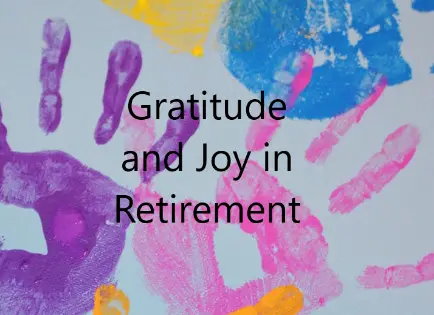A Joyful Retirement is a Grateful One
Do you want more joy in retirement? If so, practice gratitude.
Gratitude and joy are necessary to live the good life. So why not increase the joy of retirement by cultivating gratitude?
Why Does Gratitude Make You Happy?
Why does gratitude make you happy? I will review some of the neurobiochemistry below (I know you are waiting with bated breath), but first, let’s think about it.
What is the thief of joy? Comparison. The hedonic treadmill and keeping up with the Jones. You know how the ultra-rich can never be rich enough because someone is always richer? This is why the opposite of scarcity is enough rather than abundance.
If you spend time thinking about what other people think, you will be alone and miss out on belonging. Give more time and energy to what you feel and want because that is what you can control—you cannot control other people. Bring joy by expressing gratitude.
Expressing gratitude. Practicing it. Cultivating gratitude is the key.
Cultivating Gratitude
Like a muscle, you are more grateful as you use gratitude. It is a gift that keeps giving. With honest expressions of gratitude, you fill others’ hearts as you fill yours.
Your cup is full even if you think it is half full. It is full of water and air. There is no such thing as an empty cup because air fills whatever liquid vacates. Fill your cup and fill others by being grateful. The more gratitude you practice, the more you have to give and the more joy you will receive.
Ways to be More Grateful in Retirement
Let’s think about a few ways to be more grateful. Cultivating gratitude in retirement ensures a long, bountiful life.
Review old photo albums and find good pictures of friends or loved ones. Then, write them a short letter reminiscing and remind yourself of what you have to be grateful for.
Pick a day of the week and email someone different every week to surprise them with a short sentiment of gratitude for being in your life.
Before a meal, say what you are grateful for today.
When something strikes you—a sight or sound, a taste or smell—stop, breathe, and close your eyes. Bask in the grateful joy of a pleasing sensation. This sensory meditation will flood you with calm happiness.
Greet the sunrise or sunset with all you are grateful for today.
Take a nature walk and focus on gratitude for all living things.
More than an attitude of gratitude, practice it. For example, tell someone you see every day what makes them special and that you appreciate them.
Write a random note of gratitude for someone and leave it for them anonymously.
Find a reason to say “thank you” to the next five people you interact with.
Talk to yourself with love. Yes, practice gratitude, kindness, and compassion for yourself!
Hit “reply all” when you are grateful—think twice about responding with criticism.
Holidays are a perfect time to remind your family of gratitude. Be specific.
Numbing and Gratitude
Remember, we all numb our feelings, and when we numb the bad, we feel less of the good as well.
Instead of your favorite numbing technique, try calling someone and telling them to shut up for a couple of minutes because you want to tell them how great they are.
If nothing else, the icing on the cake is more good fortune. But the best has already come—the present sense of gratitude. Life will not always go your way, but ride that ride when it does.
Data Supports Gratitude as an Ebullient
In the research, we learned that the most effective way to cultivate joy in our lives is to practice gratitude. The key word here is practice. It’s not just about feeling grateful, it’s about developing an observable practice. So often we think that joy makes us grateful, when in reality it’s gratitude that brings joy. The data supporting this finding was so persuasive that we started a daily gratitude practice in our home. We now go around the table every night before dinner and share one thing for which we are grateful. ~Brene Brown
Expression of gratitude increases serotonin, norepinephrine, and dopamine in the brain. Further, gratitude decreases stress, anxiety, and depression. (source)
Gratitude also increases brain activity (fMRI) in the anterior cingulate cortex and medial prefrontal cortex. These areas are associated with empathy, reward, and moral/social cognition. It also downregulates the sympathomedulary pathway and subsequent cortisol release. Important stuff! (source)
As we well know, happiness is a choice. Joy is also biochemical, and the same brain biochemistry associated with expressions of gratitude are responsible for joy. (source)
Finally, fMRI links the happiness associated with striatal activity to an increase in temporoparietal junction to ventral striatum activity associated with generosity. Phew, I was worried about that one. (source).
Summary-Gratitude in Retirement to Increase Joy
Remember: if you are joyful, you should be grateful.
If you are grateful, you will be joyful.
Who are you in retirement? If you want to figure out who you really are, start with what you are already grateful for.
The cultivation of gratitude invites joy and happiness into our hearts. What do joy and gratitude have in common? Aside from common neurobiochemistry, both are spiritual practices that lead to a Retirement Revelation. That is, both are practices of interconnection with others and with the universe at large.
Connection and belonging are important in life, as in retirement. If you want to improve connection and belonging, be grateful and thus joyful. You don’t have to chase happiness—you can find it in front of your eyes when you see through a lens of gratitude.

